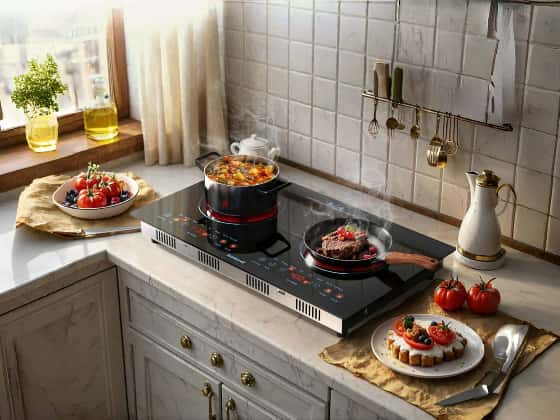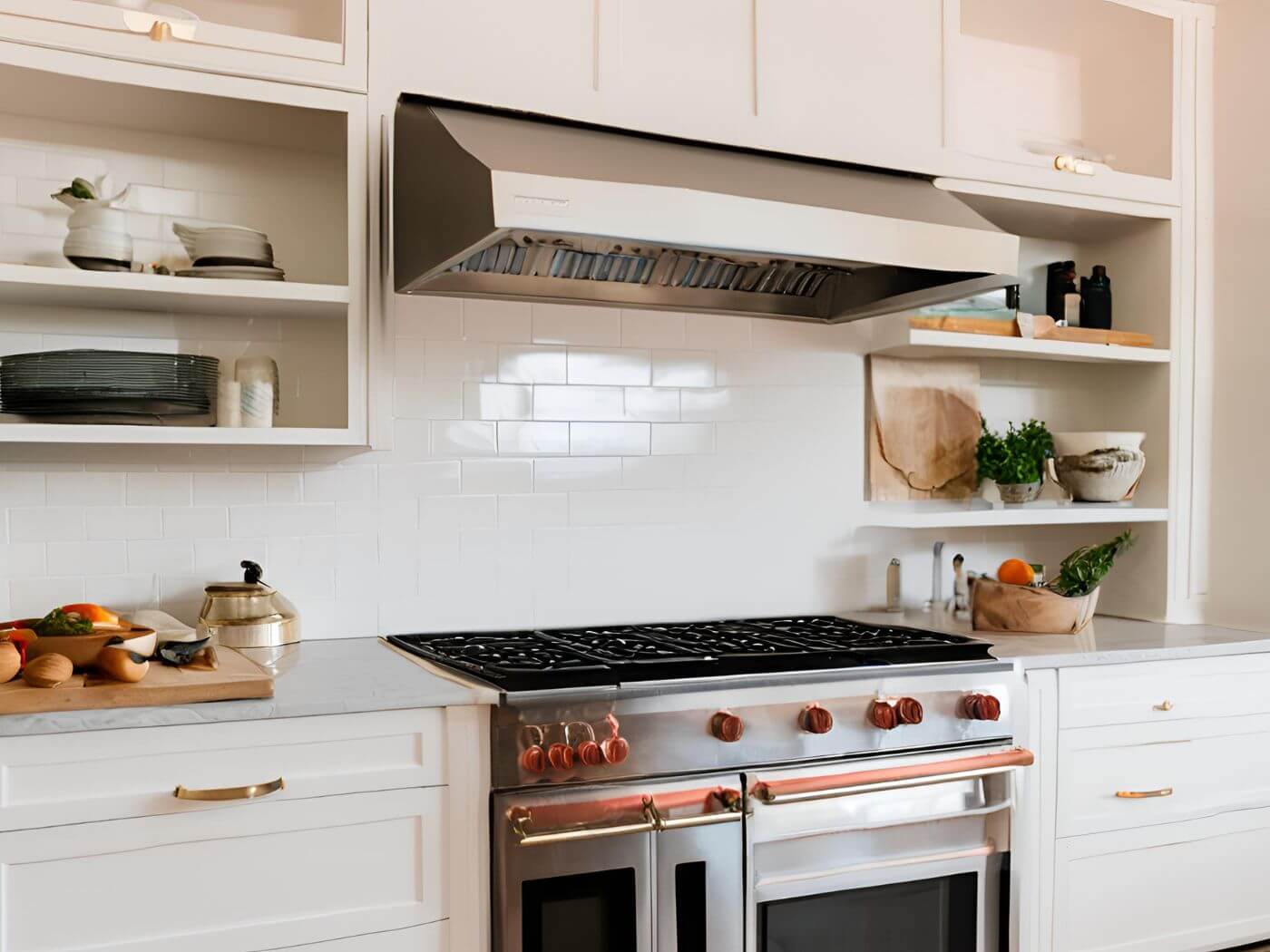
The ventilation problem of electric stove tops cannot be ignored
Accumulation of smoke and odors: When cooking on an electric stove, smoke and strong odors can quickly fill the kitchen if there is insufficient ventilation. This can be unpleasant and potentially harmful to your health if inhaled over an extended period.
Heat buildup: Electric stoves generate significant heat during operation, and without proper ventilation, this heat can accumulate in the kitchen, making it uncomfortable and potentially damaging surrounding surfaces or appliances.
Condensation and moisture buildup: Steam and moisture from cooking can condense on surfaces if not properly vented, leading to potential mold growth and damage to cabinets, walls, and other areas.
Grease buildup: Grease and cooking oils can accumulate on surfaces, appliances, and in the ventilation system itself if not properly removed, creating a potential fire hazard and making cleaning more difficult.
By addressing these common ventilation issues, you can create a safer, more comfortable, and more efficient cooking environment.
Different types of stove ventilation systems
Range hoods: These are mounted above the stove and are designed to capture smoke, steam, and odors directly from the cooking surface. Range hoods can be vented to the outside or recirculating, with the latter using filters to remove contaminants before recirculating the air back into the kitchen.
Downdraft ventilation: Instead of being mounted above the stove, downdraft ventilation systems are integrated into the electric cooktops itself. They capture smoke and odors from the cooking surface and vent them out through a duct system.
Over-the-range microwaves with ventilation: Many over-the-range microwaves come equipped with built-in ventilation systems that can help remove smoke, steam, and odors from the cooking area.
Ceiling-mounted ventilation fans: In some kitchens, a ceiling-mounted ventilation fan can be used to help circulate air and remove contaminants from the cooking area.
Portable ventilation units: For those with limited space or without a permanent ventilation system, portable ventilation units can be placed near the cooking area to help capture smoke, steam, and odors.
Practical ways to improve ventilation on electric stove tops
Clean your ventilation system regularly: Accumulated grease, dust, and debris can reduce the efficiency of your ventilation system and potentially create a fire hazard. Follow the manufacturer's recommendations for cleaning and maintaining your system.
Use the ventilation system during and after cooking: Turn on your range hood, downdraft ventilation, or portable unit before you begin cooking, and leave it running for a few minutes after you've finished to ensure all smoke and odors are removed.
Consider upgrading or replacing your ventilation system: If your current system is outdated, inefficient, or simply not meeting your needs, consider upgrading or replacing it with a more powerful and efficient model.
Open windows and doors: In addition to using your ventilation system, opening windows and doors can help improve air circulation and remove cooking odors and contaminants from the kitchen.
Solutions for specific ventilation issues with electric cooktops
Smoke and odors lingering after cooking:
Check for obstructions in the ventilation system or ductwork that could be blocking airflow.
Increase the fan speed or consider upgrading to a more powerful ventilation system.
Use a portable air purifier or deodorizer to help remove lingering odors.
Excessive heat buildup:
Ensure that your ventilation system is properly vented to the outside, as recirculating systems may not be as effective at removing heat.
Consider adding additional ventilation fans or opening windows to improve air circulation.
Use the ventilation system during and after cooking to help remove excess heat.
Condensation and moisture buildup:
Check for proper insulation and sealing around windows, doors, and other potential sources of moisture intrusion.
Use a dehumidifier or moisture-absorbing products to help control humidity levels in the kitchen.
Ensure that your ventilation system is properly vented to the outside to remove moisture effectively.
Grease buildup on surfaces and in the ventilation system:
Clean the ventilation system regularly, following the manufacturer's recommendations.
Use high-quality filters or grease traps to capture more grease and oils before they can accumulate.
Consider upgrading to a ventilation system with better grease-capturing capabilities.
Noise or vibration issues:
Check for proper installation and mounting of the ventilation system, as loose components can cause noise and vibration.
Replace worn or damaged parts, such as fan blades or motors, that may be causing excessive noise.
Consider adding sound-dampening materials or insulation around the ventilation system to reduce noise transmission.
Comparison of ventilation solutions
Range hoods:
Pros: Effective at capturing smoke, steam, and odors directly from the cooking surface; can be vented to the outside or recirculating; available in various sizes and styles to fit different kitchen layouts.
Cons: Can be expensive to install, especially if ductwork needs to be added; may require professional installation; can be noisy at higher fan speeds.
Downdraft ventilation:
Pros: Integrated into the electric cooktops, providing a sleek and seamless look; captures smoke and odors at the source; can be vented to the outside or recirculating.
Cons: Limited capture area compared to range hoods; can be less effective for capturing smoke and odors from larger cooking surfaces; may require professional installation.
Over-the-range microwaves with ventilation:
Pros: Combines a microwave and ventilation system in one unit, saving counter space; can be vented to the outside or recirculating; typically more affordable than standalone range hoods.
Cons: Limited capture area compared to dedicated range hoods; may not be as powerful or effective as standalone ventilation systems; can be noisy at higher fan speeds.
Ceiling-mounted ventilation fans:
Pros: Can help improve overall air circulation in the kitchen; relatively inexpensive to install; can be vented to the outside or recirculating.
Cons: Less effective at capturing smoke and odors directly from the cooking surface; may not be suitable for larger or open-concept kitchens.
Portable ventilation units:
Pros: Flexible and easy to move around the kitchen; no permanent installation required; can be used with electric stove tops, electric cooktops, and portable electric stoves.
Cons: Limited capture area and effectiveness compared to permanent ventilation systems; may require frequent filter replacements; can be noisy and take up counter space.
Conclusion
Proper ventilation is essential for maintaining a safe, comfortable, and efficient cooking environment when using electric cooktops.The specific ventilation needs and solutions may vary depending on the type of electric stove top or electric cooktops you have, as well as the layout and size of your kitchen.










